Until this May, my field research experiences have primarily been based in warm and sunny, locations – namely the Bahamas, Australia, and South Florida. I guess that even North Carolina in the summer counts as a warm, sunny research site, although this took some convincing after moving there from Miami.
Working in warm places has been convenient for me for many reasons. It’s great to be outside all day, friends always want to visit for a vacation, you get lots of vitamin D from the sun, and I always have a tan. About a month ago when I started preparing for this Antarctic research trip, I quickly realized that I am aptly prepared for warm weather research. I have an entire closet full of shorts, t-shirts, swimsuits, and sunglasses. One cabinet in my bathroom is dedicated to the tubes of sunblock that I am routinely purchasing. However, despite growing up in Michigan and doing my undergraduate degree in Ohio, I severely lack in cold weather gear, which means I actually had to buy new field gear for this trip to Antarctica. I haven’t had to do that in years! As many of you know, we field biologists do not tend to buy (or even wear) new field clothes. I still wear many shirts for fieldwork that have permanent “shark slime” on them, are rust stained, or are just plain dirty.
My lack of “extreme” cold weather gear was just the beginning. Since arriving at 63 degrees South, I have discovered some other important differences between the tropical research that I am accustomed to and the Antarctic research that I am currently in the midst of.
Darkness.
In other parts of the world (including my familiar tropical research sites), a normal day starts early. For example, at the Duke Marine Lab we often meet between 5:30 and 6:30 am to begin our fieldwork off the coast of North Carolina. However, it’s now June (the beginning of winter) in Antarctica and our days have been starting progressively later and later (approximately seven minutes later each day). Today we launched the small boats at 9:15 am as it was just getting light. Now, it’s important to note that this does not mean that we get less work done in Antarctica. I had the chance to go out on the tagging boat today with Ari, Alison, and our exceptional driver, Lily. Observers had spotted seven whales from the ice tower of the RVIB NB Palmer while we were launching the small boats, so once we splashed we headed straight for a group of three whales. Alison skillfully had our first tag on around 9:40 am, and Ari followed by sticking a second tag around 10:15am (record time for our cruise, I might add). Ari easily obtained biopsy samples from all three whales in the group before lunch. You couldn’t ask for a more productive morning!
|
|
Water.
There is an obvious difference between the warm, welcoming water of the tropics and icy, cold Antarctic water. None of us on this trip desire a refreshing mid-day dip to cool off. Even after a gym workout we are quite happy to indulge in a hot shower. Just reaching over the side of the boat to pick up a tag is a chilling experience (although strangely Ari seems to manage fine with wet hands and no gloves). We are more likely to have a mid-day dance party (not uncommon) to try to stay warm here (a music video might be in our future). Another difference regarding water is the amount of water that I drink while working on the small boats. On a typical research day in the tropics, I would make sure to drink between two and three liters of refreshing water a day. However, here in Antarctica there are two concerns with drinking lots of water. One is that it’s just not hot out. Secondly, there is the ever-present fear of drinking too much water while you are wearing multiple layers of clothing and covered still by a thick Mustang float suit. Getting out of these layers would not be an easy process. (Don’t worry, Mom, when we’re doing visual observations from the NBP there is no fear of drinking water and we all do a very good job of hydrating ourselves throughout the day.)
Clothing.
As I’ve mentioned, the clothing that we wear in Antarctica is very different from the bathing suit that would suffice for tropical research. For our Antarctic visual surveys we are outside on the ice tower for 30 minutes at a time, sometimes in brutal wind (read some of the earlier blog posts for examples of the brutality of the wind… I will always remember Lindsey shouting “Off effort! Off effort!” when Danielle and I had the joy of experiencing a 60 knot gust (high) up on the ice tower a few days ago). The preparation prior to going out on the ice tower takes some time and often involves help from another team member (picture a dad zipping up his daughter’s jacket, or a mom yanking on her son’s gloves). Preparing to spend the day working on the small boats also takes time and forethought. For example, Joy, one of our krill biologists, put on four pairs of socks, three sets of long underwear, leisure pants, fleece pants, and a fleece jacket under her unmistakable orange Mustang float suit before heading out on the prey boat today.
Weather challenges.
In the Bahamas, we would always be on the lookout for waterspouts (like a tornado on the water). In Florida, we could expect a summer afternoon thunderstorm (usually right at 2:15 pm). In Shark Bay, Australia, high winds would drive us off the water. Here in Antarctica, however, we have the added hazard of snow. Today, we had 3 knots of wind (which is pretty spectacular after having a few days of really high wind) and glassy water. It was a gorgeous and fruitful morning, but snow started to fall around 1:30 pm (close to sunset) and we had to head back to the NBP because visibility had decreased dramatically (which can happen in a matter of minutes down here). Our marine technicians and the NBP crew do an exceptional job at handling the dynamic and often temperamental weather conditions here, despite our frustration at getting snowed out at times. Despite an afternoon whiteout, we got two tags out today so we’re not complaining!
There are also some other, more subtle differences. Instead of sunglasses, we wear ski goggles. Instead of sunburn, we get windburn. Instead of looking at sandy beaches, we see magnificent icebergs and snow-covered mountains. Instead of trying to cool off after a long hot day, we spend hours after coming inside trying to get warm again (this often involves tea, hot chocolate, soup, and more layers). We also don’t have to worry about insects here, which is especially great if you are stashing chocolate supplies in your cabin.
And, of course, there are similarities between tropical and Antarctic research. Most importantly, this research cruise has a great team of scientists, technicians, and crew members all working together toward common goals. In addition to our hard work, we all have a great time together (even if the ping-pong tournaments or soccer matches get a little heated) and try to make special days still feel special (HAPPY BIRTHDAY, ANDY!).
-Meagan

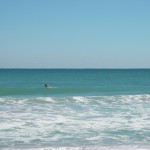
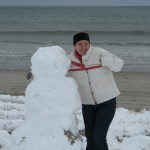

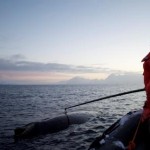
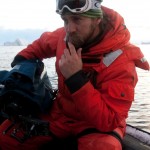
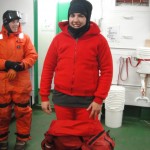

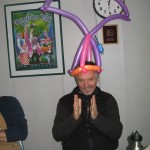
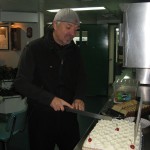

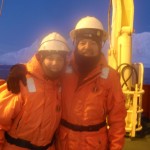
Of Hydration and Chocolate
Glad to know you’re staying hydrated, Meagan! To tell you the truth, your hydration hasn’t been one of my very top concerns while you’ve been in Antarctica. (But I do hope your chocolate stash is holding out:)
It’s been wonderful to be able to follow the research mission via this blog. Wishing you, your team, and all the crew a safe trip home. Traveling mercies!
My little Mea Mea or is it Mae Mae?! HA!
Who doesn’t like shark slime on their clothes? Come on!
Sounds quite a bit different than the warm waters you’re used to Meagan.
A little windburn never hurt anyone eh?!
Keep taggin’ those whales. You rock.
I’ll take you on in Ping Pong any day girrrrl. Hope to see you in July if you’re home.
Auntie Lanny